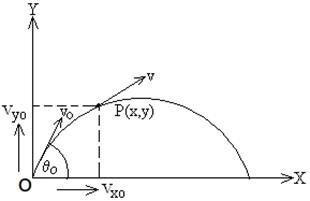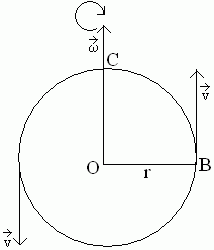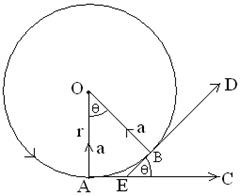Two Dimensional Motion
Contents
Two Dimensional Motion

Two Dimensional Motion
Two Dimensional Motion
Questions: Deduce the equations below by vector method.
![]()
![]()
![]()
Let, a body moves with uniform acceleration![]() , Let, at time ti = 0, then initial position vector
, Let, at time ti = 0, then initial position vector
![]() , and initial velocity
, and initial velocity![]() , Again time tf = t, then final position vector
, Again time tf = t, then final position vector![]() and final velocity
and final velocity ![]()
In physics, acceleration is the rate at which the velocity of a body changes with time.
![]()
When, t = 0, then ![]() and when t = t then
and when t = t then![]() , in this range, Integrate the above equation,
, in this range, Integrate the above equation,

![]()
![]()
Let, a body moves with uniform acceleration![]() , Let, at time ti = 0, then initial position vector
, Let, at time ti = 0, then initial position vector
![]() , and initial velocity
, and initial velocity![]() , Again time tf = t, then final position vector
, Again time tf = t, then final position vector![]() and final velocity
and final velocity ![]()
So, after t second the average velocity of the particle is
![]()
![]()

![]()
![]()
![]()
![]()
Let, a body moves with uniform acceleration![]() , Let, at time ti = 0, then initial position vector
, Let, at time ti = 0, then initial position vector
![]() , and initial velocity
, and initial velocity![]() , Again time tf = t, then final position vector
, Again time tf = t, then final position vector![]() and final velocity
and final velocity ![]()
In physics, acceleration is the rate at which the velocity of a body changes with time.
![]()
![]()
When, t = 0, then ![]() and when tf = t then
and when tf = t then![]() , in this range, Integrate the above equation,
, in this range, Integrate the above equation,
equation we get,

![]()
![]()
![]()
![]()
Since, the velocity of a moving body is defined as its rate of displacement so by the definition,
![]()
![]()
When, ti = 0, then ![]() and when, tf = t then
and when, tf = t then![]() , in this range, Integrate the above equation we get,
, in this range, Integrate the above equation we get,

![]()
![]()
![]()
![]()
![]()
Let, a body moves with uniform acceleration ![]() . Let, at time ti=0 then initial position vector
. Let, at time ti=0 then initial position vector ![]() and Initial velocity
and Initial velocity![]() , Again time tf = t then final position vector
, Again time tf = t then final position vector ![]() and final velocity
and final velocity![]() .
.
In physics, acceleration is the rate at which the velocity of a body changes with time.
![]()
![]()
When, t= 0, then ![]() and when, t = t then
and when, t = t then![]() , in this range, Integrate the above equation we get,
, in this range, Integrate the above equation we get,
![clip_image048[1] clip_image048[1]](https://saiftheboss7.files.wordpress.com/2012/09/clip_image0481_thumb1.gif?resize=88%2C59&quality=100)
![]()
![]()
![]()
![]()
By dot product of ![]() we get,
we get,
![]()
![]()
![]()
![]()

![]()
Two Dimensional Motion
Projectile:
Projectile motion is the act of projecting an object into the air at an angle. A few real life examples of projectile motion are throwing a tennis ball, the motion of football, missile etc.
Two Dimensional Motion
Equation of motion of a projectile:
Let a projectile begin its flight from a point O (Fig: right side) Taking
O as Origin and let the horizontal and vertical direction be considered along
 X and Y-axis respectively.
X and Y-axis respectively.
Let the initial velocity or
velocity of projection = vo
Angle of Projection = θo
The horizontal acceleration
of the projectile, ax = 0;
The vertical acceleration of
the projectile, ay = -g;
Since ay is negative because
the direction of g is negative,
Since the point of projection
and origin is same, ∴ xo = yo = 0
The horizontal component of initial velocity = vo cosθo
And the vertical component of initial velocity = vo sinθo
The change of motion along X-axis is dependent on acceleration along X-axis.
The change of motion along Y-axis is dependent on acceleration along Y-axis.
At a certain interval of time t, the projectile cross the point P(x, y) where its velocity is = v
Then the acceleration along X-axis is, ax = 0
Displacement along X-axis is = x
x = vocosθot + ½axt2
or, x = vocosθot + 0[∵ax = 0]
or, x = vocosθot
![]()
The acceleration along Y-axis is, ay= g;
Displacement along Y-axis is = y
y = vo sinθot – ½gt2
 [By putting the value of t]
[By putting the value of t]


This is an equation of a parabola. ∴ Path of motion of projectile is parabolic.
Questions: In case of Projectile Find the expression of (i) Required time to reach the maximum height (ii) Maximum height (iii) Time of flight (iv) Range (v) Maximum Range
(i) Required time to reach the maximum height:
Let a projectile begin its flight from a point O (In Fig) Taking O as Origin and let the horizontal and vertical direction be considered along X and Y-axis respectively. At a certain interval of time t, the projectile stay at the point P(x, y) where its velocity is = v
(i) Time to reach maximum height:
Vertical component of vo isvo sinθo
After time t, the final velocity at maximum height,

vy = vosinθo– gt………………(1)
But the velocity at maximum height, vy= 0…………. (2)
By putting the value, vy= 0, in equation (1)
(1) 0 = vo sinθo – gt
![]()
(ii) Maximum height :
Let, the maximum height be H
∴H = vo sin θo t – ½ gt2


![]()
(iii) Time of Flight :
Let, the time of flight T i.e. is time taken from the point of projection and return to the ground is T.
Vertical displacement at time t, y = vo sin θ ot – ½gt2. Let the time of flight be T. In time T the projectile returns to the ground. I.e. t = T and y = 0,
0 = vosin θ oT – ½gT2
or, ½ gT2= vo sin θoT
![]()
(iv) Range :
Let, Range =R, R is the distance travelled along the horizontal direction in the time of flight T.
∴R = ( vocos θ o ) × T
![]() [By putting the value of T from Eq. (5)]
[By putting the value of T from Eq. (5)]
![]()

Maximum Range:
Let Rmax be the maximum range, R will be maximum when sin2θ 0 = 1
or, Sin2θ 0 = Sin900
or, 2θ 0 = 900
∴ θ0 = 450 so, if a body is thrown at an angle 450 with the horizontal direction, the range will be maximum.
∴Maximum range, ![]()
![]()
![]()
![]()
Angular acceleration and proof of ![]() :
:
Angular acceleration of an object in circular motion is defined as the time rate of change of its angular velocity. it is generally denoted by α.
Let![]() be the change in angular velocity of the object in time interval t and
be the change in angular velocity of the object in time interval t and ![]() while moving on a circular path, then angular acceleration of the object will be,
while moving on a circular path, then angular acceleration of the object will be, ![]()
S.I unit of angular acceleration is rad s-2.
We know that linear velocity v is denoted with angular velocity ![]() by by the relation
by by the relation ![]()
Differentiating![]() with respect to time, we have
with respect to time, we have
![]()
![]()
∴a=rα where a is the linear acceleration and α is the angular acceleration.
In terms of vector rotation, we have ![]()
Linear velocity and Angular velocity and Relation of ![]() :
:
Linear velocity:
The rate of change of displacement is called linear velocity. Velocity is the speed of an object and a specification of its direction of motion. Speed describes only how fast an object is moving, whereas linear velocity gives both how fast and in what direction the object is moving. The linear velocity of a moving body is defined as its rate of displacement. The linear velocity may be uniform or variable. It is donated by ![]() . It is a vector quantity and it’s unit is ms-1. Velocity,
. It is a vector quantity and it’s unit is ms-1. Velocity,![]()
Angular velocity:
angular velocity of an object in circular motion is defined as the time rate of change of its angular displacement. It is denoted by![]() .
.
Let, ![]() be the angle through which the body moves in time
be the angle through which the body moves in time ![]() Angular Velocity;
Angular Velocity; ![]() .
.
The unit of angular velocity is rad s-1
The Dimension of angular velocity is ![]()
Relation:
Let us consider an object is moving along a circular path of radius r = OC=OB, in a anti clock wise direction with a uniform angular velocity. If the object rotted one turn in T second then angular displacement ![]()
![]()
 Naw in T Sec. the object travels
Naw in T Sec. the object travels ![]()
![]()

![]()
From equation (1) and (2) we gate
![]()
![]()
![]() Linear velocity = angular velocity × radius of the circle.
Linear velocity = angular velocity × radius of the circle.
Again, We know ![]() is a vector quantity and radius vector is also a vector quantity. Therefore, the cross product of two vectors will also be a vector. Let the resultant of the cross product
is a vector quantity and radius vector is also a vector quantity. Therefore, the cross product of two vectors will also be a vector. Let the resultant of the cross product![]()
![]()
The magnitude of ![]() is
is
![]()
![]()
![]()
In addition, the direction ![]() are the same (according to the rule of cross-product)
are the same (according to the rule of cross-product)
![]()
So, from equation (4) and (5)
![]()
Difference between Angular Velocity and Linear Velocity:
| Sl.no | Angular velocity | Linear velocity |
| 1. | The rate of change of angular displacement is known as angular velocity. | The rate of change of linear displacement is known as angular velocity. |
| 2. | It is denoted by |
It is denoted by v |
| 3. | Unit of it is rads-1 | Unit of it is ms-1 |
| 4. | Dimensional equation of it is [T-1] | Dimensional equation of it is [LT-1] |
| 5. | It does not depend on displacement. | It depends on displacement. |
Centripetal Force:
The external force required to make a body moves along circular path with uniform speed is called centripetal force. Mathematically, the centripetal force required to move a body of massm along a circular path of radius r is given by,![]() .
.
Centrifugal Force :
An object traveling in a circle behaves as if it is experiencing an outward force. This force, known as the centrifugal force, depends on the mass of the object, the speed of rotation, and the distance from the center. The more massive the object, the greater the force; the greater the speed of the object, the greater the force; and the greater the distance from the center, the greater the force. Mathematically, the centrifugal force required to move a body of mass m along a circular path of radius r is given by,![]() .
.
Expression for centripetal acceleration and centripetal force:
Let us consider an object of mass m is moving along a circular path of radius r, in anticlockwise direction with a uniform speed v, and an angular velocity ![]() with at center O. When the body is come from A to B in small time variation t. The velocity at A is the Tangent along AC.
with at center O. When the body is come from A to B in small time variation t. The velocity at A is the Tangent along AC.
Now, in rectangular OAEB, we get
 ∠AEB+∠AOB =180°
∠AEB+∠AOB =180°
Again, ∠AEB+∠BEC = 180°
Spouse, ∠AOB = ∠BEC = θ
The horizontal component of velocity at A, vy = 0
and the vertical component, vx = v
The vertical component of velocity along AC, vy = vsinθ
and the horizontal component, vx = vcosθ
when t is very small then θ is also very small
∴ sin θ = θ, and cos θ = 1
∴ the vertical component of velocity at B, vy = vθ
and the horizontal component, vx = v
It appears that, there is no change of velocity along horizontally,
So, centripetal acceleration,
![]()
![]()
![]()
![]()
![]()
![]()
![]()
and Centripetal Force = ![]()
To Download Two Dimensional Motion in PDF format Click Here
Two Dimensional Motion
Two Dimensional Motion
Two Dimensional Motion
Two Dimensional Motion
Two Dimensional Motion
